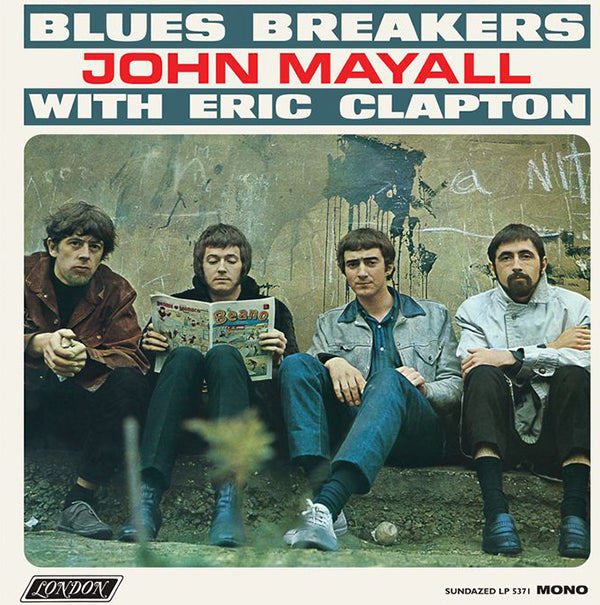As common as it is to read statements from rock and roll musicians that “when I saw The Beatles on the Ed Sullivan show, I knew I wanted to be a rock musician,” so the following statement goes with just about any guitar player over 45:
“When I heard Eric Clapton play the blues on the John Mayall and the Blues Breakers album, I knew that I wanted to play like that!”
So, to be clear, as much as Mike Bloomfield lit the fire and Keith Richards and Chuck Berry set the direction, it wasn’t until I heard the searing blues playing of Eric Clapton on the Blues Breakers album that it all came together.
All of this happened pretty quickly, as I heard Mike Bloomfield, then Keith and Chuck, all around 1966.
By the time I started to digest it all, my neighbor Mike played Fresh Cream for me. This was also in 1966, December to be exact. When I heard the opening track “I Feel Free” and the unreal-sounding guitar solo (which sounded like a combination of a vocal and a violin) Clapton’s guitar tone (famously called “woman tone” because of its sound like a crying woman, I guess) was electrifying and mesmerizing.
I knew that I wanted to get that tone but it didn’t register as to how and why a guitar could sound like that. It certainly was not a Fender guitar.
The guitar in fact was a Gibson Les Paul.
The amp Clapton used wasn’t a Fender either, it was a British amp I had never heard of called Marshall.
This guitar tone was alien to US musicians who really only knew pretty clean (read: non-distorting) guitar sounds.
I can’t remember exactly the next step but somehow I read about the band Clapton quit to start Cream.
The band he walked out on (a Clapton trait that has followed him all his life, much to the chagrin of the dozens of musicians that he left behind) was the album by John Mayall with Eric Clapton, the Blues Breakers LP. I bought what is now famously known as the “Beano” album because Clapton is holding a copy of a comic book called Beano on the front cover.
I put on the first track, “All Your Love” and bam, it was all over. The guitar solos were just perfect in ways that I never heard before and… the guitar tone?
The picture on the back showed Eric with the Les Paul.
I thought that Les Paul was a guitar brand, not a model of Gibson guitars.
The amp, a Marshall looked different then any other amp I had ever seen.
As the album progressed, Clapton’s playing just got better and more intense. Clapton played with the amp on 10 and all that overdrive distortion coupled with Clapton's superior finger vibrato gave me the road map for the tone that I, with one more added ingredient coming in Part Four, built my sound on.
Clapton’s performance on the instrumental “Steppin’ Out” and his solo on “Have You Heard” make me shudder to this very day.
In December of 1967 Cream’s Disraeli Gears, followed by the Cream’s album Wheels of Fire cemented Clapton’s legend.
To many of us, his playing has never surpassed this era.
I listen to the song and the solo on “Strange Brew” daily.
Clapton has of course gone on to have an amazing career. His two other contemporaries also had amazing careers: Jimmy Page and Jeff Beck. To compare these three, it goes something like this:
Jeff Beck is by far the most creative and innovative of the three. I saw Beck a few years ago and he just seems to get better with age. He can do anything Clapton can do, plus voice his guitar tones like few others on this Earth can.
Jimmy Page (by far the most financially successful because of the titanic record sales of Led Zeppelin) has suffered as drugs and alcohol really took away his talent.
Always the sloppiest of the three, he at least was a better songwriter and also a very good producer. I have seen Page many times starting in 1969, front row at Zep’s first ever NYC appearance. He was really good then (1969 – 1972) but sadly, he is no longer among the top tier of players.
Where does that leave Clapton?
Clapton truly is a one-trick pony and can, in concert, either be inspired to play blues with a feeling that can take your breath away, or sleepwalk through a very boring set. I’ve seen him in every way including Cream in 1967 and the Cream reunion in 2005.
That reunion was about as sad as could be. It wasn’t Cream, it was skimmed milk.
They looked like three old men at the betting window at the dog track in Hialeah, Florida.
I realized that it was the youthful aggression that made the original Cream so absolutely transcendent, which was based on the fact that they hated each other. That plus the extreme volume created by the mega Marshall amps they were using at the time, created the sonic tour-de-force audio palette that launched a thousand guitar players.
Read Clapton’s autobiography. It is as sad as it is illuminating. I couldn’t put it down.
So: as you can see, I still hold Mr. C in very high regard.
But, back to 1967, there was one ingredient left that I didn’t know existed until I read a review of the artist and album.
It was only when I heard my next influence that everything came together in one neat package, a package that very much involved Eric’s style, and it all made total sense.
This article was first published in Issue 59 and appears here in slightly updated form.


